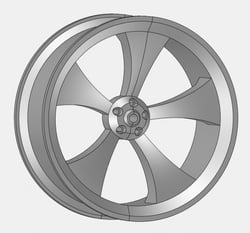 1. Don't Reinvent the Wheel
1. Don't Reinvent the Wheel
You're designing a new product, but you have an old part that's almost right for the job. Don't redesign it from scratch, import it from its source format and tweak it to meet your current needs.
2. Keep it Tight
If you're designing a part for manufacturing, you need the end product to be water-tight. If your model is “leaky”, your production run might just sink before it gets ever gets launched. If you’re re-using data files and they are not in the best of shape, importing them may help to patch some of those holes during the healing phase and make for clear sailing during production. In this way, data re-use not only extends the life of the model, but it may very well make your model ship-shape to boot!
3. Beauty AND/OR the Beast
Sometimes you just want to show off your model so all you really need is a "glam shot" of your little beauty, but other times you need to work with your model which means loading the whole big beast into your application. You should be able load only the stuff you want when you want it.
4. Garbage In, Garbage Out...or Maybe Not!
If you have models that are a little "dirty", don't throw them out! Clean them up with healing during translation. Models are precious resources and they can have a very long shelf-life. But over the course of time, old data formats fall out of favor and make way for new ones. That doesn’t mean you have to take your old models to the thrift store, but you might need to translate them into a new format. With high-quality translations that include healing, you can effectively refurbish your old models and make them new again. Data re-use can make your old junk into a new treasure.
5. Maximize Your Resources
You've already made an investment in model design, now it's time to get the most from your model by maximizing the number of applications that can work with it. High fidelity translations between a wide variety of formats naturally increase your opportunities to re-use your model.
Valuable development resources should focus on solving your customers’ needs. Adding data interoperability shouldn't be a burden. A simple interface allows your developers to maximize their time working on adding value to your application.
Design and production requires different kinds of data at different points in the process. Getting the kinds of data you need - and no more - just when you need it maximizes your ability to collaborate all along the way.
Some of the models you work with are big, I mean HUGE, monstrous even. Maximize your time working with your model rather than going for coffee by using your machine's resources to the fullest extent possible. That means choosing an interoperability component that is multi-process and multi-thread enabled.
Leah Morgan is a Senior Developer in 3D InterOp
Learn More about 3D InterOp and Data Translation



.jpg?width=450&name=Application%20Lifecycle%20Management%20(1).jpg)














